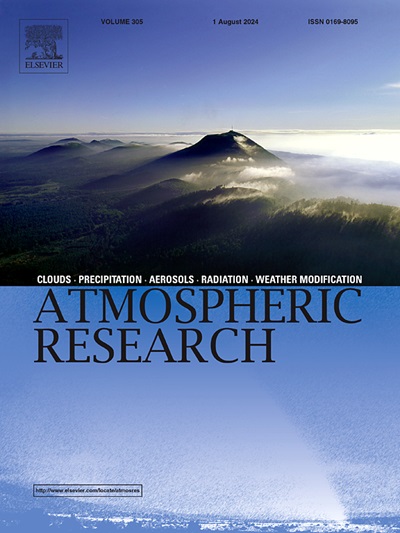Hierarchical clustering for diurnal cycles of lightning using LIS satellite data
IF 4.4
2区 地球科学
Q1 METEOROLOGY & ATMOSPHERIC SCIENCES
引用次数: 0
Abstract
This article harnesses data from the Lightning Imaging Sensor (LIS) to explore global diurnal cycles of lightning (DCL) spanning the period from 1998 to 2015. Lightning parameters—frequency, radiance, and footprint—were standardized to a 0.5° × 0.5° resolution grid and segmented into distinct diurnal patterns using the Bisecting K-Means algorithm. Across these patterns, significant differences emerge between ocean and land lightning activity. Globally, lightning frequency demonstrates a unimodal variation, reaching a peak at 16:00 and a valley at 10:00, driven by solar heating of the landmass and contributed to predominantly by lightning over land. The land/ocean frequency ratio shifts dynamically throughout the day, ranging from 0.70 to 11.36. Ocean lightning consistently shows higher radiance and footprint than land. The ocean/land radiance and footprint ratio follow a similar diurnal trend as frequency, ranging from 1.33 to 2.22 and from 1.16 to 1.39, respectively. Clustering analysis underscores the contrasting dynamics of land and ocean, with ocean lightning concentrated during nighttime hours, while land lightning peaks in the afternoon and evening. Transitional zones with distinct clusters are observed along the coastline. Furthermore, DCLs reveal differences across the three lightning parameters: frequency trends are more temporal concentrations, whereas radiance and footprint clusters span broader time periods. DCLs exhibit pronounced spatial heterogeneity across latitude, distance from coastline, and elevation. The clustering patterns shift at different critical latitudes for each parameter, with hemispheric asymmetry in distribution patterns. Clusters exhibit distinct distance-variation patterns over land and ocean, with nocturnal activity patterns becoming dominant with increasing elevation. This study fills a pivotal gap in global DCL research and provides important clues for studying lightning mechanisms, thereby contributing to the development of effective global lightning protection strategies.
利用LIS卫星数据对闪电日周期进行分层聚类
本文利用闪电成像传感器(LIS)的数据,探讨了1998年至2015年全球闪电日周期(DCL)。闪电参数——频率、亮度和足迹——被标准化为0.5°× 0.5°分辨率网格,并使用平分k均值算法分割成不同的日模式。在这些模式中,海洋和陆地闪电活动之间出现了显著差异。在全球范围内,闪电频率呈现单峰变化,在16:00达到峰值,在10:00达到低谷,这主要受陆地太阳加热的驱动,主要由陆地上的闪电造成。陆地/海洋频率比全天动态变化,范围从0.70到11.36。海洋闪电始终显示出比陆地更高的亮度和足迹。海洋/陆地辐射比和足迹比的日变化趋势与频率相似,分别在1.33 ~ 2.22和1.16 ~ 1.39之间。聚类分析强调了陆地和海洋的对比动态,海洋闪电集中在夜间,而陆地闪电在下午和晚上达到峰值。沿海岸线可观察到具有明显集群的过渡带。此外,dcl揭示了三个闪电参数之间的差异:频率趋势更多的是时间浓度,而辐射和足迹簇跨越更广泛的时间段。dcl在纬度、距离海岸线的距离和海拔上表现出明显的空间异质性。各参数的聚类模式在不同的临界纬度发生变化,分布模式呈半球不对称。集群在陆地和海洋上表现出明显的距离变化模式,夜间活动模式随着海拔的升高而占主导地位。该研究填补了全球DCL研究的关键性空白,为雷电机制研究提供了重要线索,有助于制定有效的全球防雷策略。
本文章由计算机程序翻译,如有差异,请以英文原文为准。
求助全文
约1分钟内获得全文
求助全文
来源期刊

Atmospheric Research
地学-气象与大气科学
CiteScore
9.40
自引率
10.90%
发文量
460
审稿时长
47 days
期刊介绍:
The journal publishes scientific papers (research papers, review articles, letters and notes) dealing with the part of the atmosphere where meteorological events occur. Attention is given to all processes extending from the earth surface to the tropopause, but special emphasis continues to be devoted to the physics of clouds, mesoscale meteorology and air pollution, i.e. atmospheric aerosols; microphysical processes; cloud dynamics and thermodynamics; numerical simulation, climatology, climate change and weather modification.
 求助内容:
求助内容: 应助结果提醒方式:
应助结果提醒方式:


